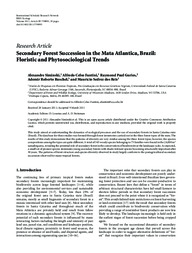Secondary forest succession in the Mata Atlantica, Brazil: floristic and phytosociological trends.
Secondary forest succession in the Mata Atlantica, Brazil: floristic and phytosociological trends.
Author(s): SIMINSKI, A.; FANTINI, A. C.; GURIES, R. P.; RUSCHEL, A. R.; REIS, M. S. dos
Summary: This study aimed at understanding the dynamics of ecological processes and the use of secondary forests in Santa Catarina state (Brazil). The data base for these studies was formed through forest inventories carried out in the three forest types of the state. The results of this study demonstrate that the patterns of diversity are very similar among the three forest types; however, the species compositions among the types are quite different. A total of 343 woody species belonging to 73 families were found in the 24,000 m2 sampling area, revealing the potential role of secondary forest in the conservation of biodiversity at the landscape scale. As expected, a small set of pioneer species dominates young secondary forests with shade-tolerant species becoming structurally important after 30 years. The patterns of forest structure and species diversity observed in study largely conform to the postagricultural secondary succession observed for many tropical forests.
Publication year: 2011
Types of publication: Journal article
Unit: Embrapa Eastern Amazon
Keywords: Brasil, Floresta Secundaria, Mata atlântica, Sucessão florestal
Observation
Some of Embrapa's publications are published as ePub files. To read them, use or download one of the following free software options to your computer or mobile device. Android: Google Play Books; IOS: iBooks; Windows and Linux: Calibre.
Access other publications
Access the Agricultural Research Database (BDPA) to consult Embrapa's full library collection and records.
Visit Embrapa Bookstore to purchase books and other publications sold by Embrapa.

